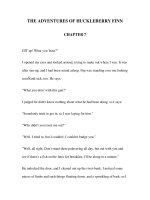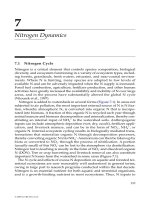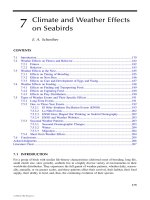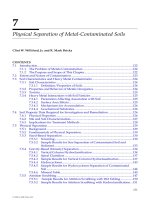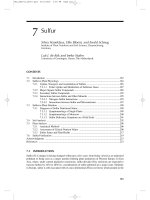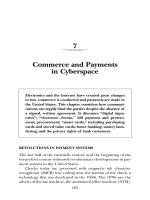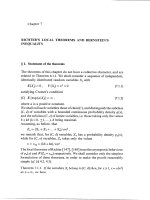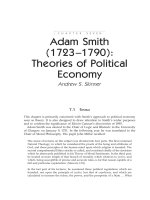Survey of accounting 6e chapter 7
Bạn đang xem bản rút gọn của tài liệu. Xem và tải ngay bản đầy đủ của tài liệu tại đây (3.03 MB, 43 trang )
Fixed Assets and Intangible
Assets
Chapter
7
©2013 Cengage Learning. All Rights Reserved. May not be scanned, copied or duplicated, or posted to a publically accessible website, in whole or in part.
Learning Objectives
After studying this chapter, you should be able to:
•
Define, classify, and account for the cost of fixed assets.
•
Compute depreciation using the straight-line and doubledeclining-balance methods.
•
Describe the accounting for the disposal of fixed assets.
•
Describe the accounting for the depletion of natural
resources.
•
Describe the accounting for intangible assets.
•
Describe how depreciation expense is reported on an
income statement, and prepare a balance sheet that
includes fixed assets and intangible assets.
©2013 Cengage Learning. All Rights Reserved. May not be scanned, copied or duplicated, or posted to a publically accessible website, in whole or in part.
Learning
Objective 1
Define, classify, and account for the cost of
fixed assets
©2013 Cengage Learning. All Rights Reserved. May not be scanned, copied or duplicated, or posted to a publically accessible website, in whole or in part.
Characteristics of Fixed Assets
• They exist physically and thus are tangible assets.
• The are owned and used by the company in its normal
operations.
• They are not offered for sale as part of normal operations.
©2013 Cengage Learning. All Rights Reserved. May not be scanned, copied or duplicated, or posted to a publically accessible website, in whole or in part.
Fixed Assets as a Percentage of
Total Assets
Exhibit 1: Fixed Assets as a Percent of Total Assets- Selected Companies
©2013 Cengage Learning. All Rights Reserved. May not be scanned, copied or duplicated, or posted to a publically accessible website, in whole or in part.
Classifying Costs
Exhibit 2: Classifying Costs
©2013 Cengage Learning. All Rights Reserved. May not be scanned, copied or duplicated, or posted to a publically accessible website, in whole or in part.
Costs to Include in Fixed Assets
Land
Building
©2013 Cengage Learning. All Rights Reserved. May not be scanned, copied or duplicated, or posted to a publically accessible website, in whole or in part.
Costs to Include in Fixed Assets
Machinery & Equipment
Land Improvements
©2013 Cengage Learning. All Rights Reserved. May not be scanned, copied or duplicated, or posted to a publically accessible website, in whole or in part.
Revenue and Capital
Expenditures
Capital Expenditures
• Are _____
improvements
• Benefit _______ and
______ periods
• Increase ______
______
Revenue
Expenditures
• Ordinary ______
and __________
• Benefit only the
_____ period
• Increase _______
and _________
expense
©2013 Cengage Learning. All Rights Reserved. May not be scanned, copied or duplicated, or posted to a publically accessible website, in whole or in part.
Revenue and Capital Expenditures
©2013 Cengage Learning. All Rights Reserved. May not be scanned, copied or duplicated, or posted to a publically accessible website, in whole or in part.
Learning
Objective 2
Compute depreciation using the straight-line and
double-declining-balance methods
©2013 Cengage Learning. All Rights Reserved. May not be scanned, copied or duplicated, or posted to a publically accessible website, in whole or in part.
Accounting for Depreciation
• Over time, fixed assets other than ____ lose their
ability to provide services.
• The cost of these fixed assets should be
expensed in a systematic manner during their
_____ lives.
• This is called depreciation.
_______
Depreciation
_________
Depreciation
• Factors include
wear and tear
• Factors include
obsolescence
©2013 Cengage Learning. All Rights Reserved. May not be scanned, copied or duplicated, or posted to a publically accessible website, in whole or in part.
Factors in Computing Depreciation
Expense
Exhibit 4: Depreciation Expense Factors
©2013 Cengage Learning. All Rights Reserved. May not be scanned, copied or duplicated, or posted to a publically accessible website, in whole or in part.
Two Common Depreciation
Methods
• Straight-Line
• Double-declining-balance
Straight-Line
– _____ amount of depreciation each year.
______ amounts of depreciation each period
Asset
acquired
Residual
value
©2013 Cengage Learning. All Rights Reserved. May not be scanned, copied or duplicated, or posted to a publically accessible website, in whole or in part.
Straight-Line
–
Annual Depreciation =
Example: Assume a $24,000 depreciable asset with an
estimated 5-year useful life and estimated $2,000 residual value.
Annual depreciation expense: ($24,000 - $2,000) / 5 = $4,400
Depreciation = $4,400 per year
Asset cost =
$24,000
Residual value
= $2,000
Rate is 1/5
OR
20% per year
©2013 Cengage Learning. All Rights Reserved. May not be scanned, copied or duplicated, or posted to a publically accessible website, in whole or in part.
Double-Declining-Balance
• Double-Declining-Balance
– Accelerated method that provides _____
depreciation in earlier years.
Depreciation expense _______ in earlier
periods
Asset
acquired
Residual
value
©2013 Cengage Learning. All Rights Reserved. May not be scanned, copied or duplicated, or posted to a publically accessible website, in whole or in part.
Double-Declining-Balance
Double the Straight-Line Rate × Book Value
Example: Assume a $24,000 depreciable asset with an estimated 5year useful life and estimated $2,000 residual value.
Double
Straight Line
Rate
Residual
Value
©2013 Cengage Learning. All Rights Reserved. May not be scanned, copied or duplicated, or posted to a publically accessible website, in whole or in part.
Comparing Depreciation Methods
Exhibit 5: Summary of Depreciation Methods
Exhibit 6: Comparing Depreciation Methods
©2013 Cengage Learning. All Rights Reserved. May not be scanned, copied or duplicated, or posted to a publically accessible website, in whole or in part.
Depreciation for Federal Income
Tax
• ________ ___________ ____ _______ _____
(MACRS)
• Specifies _____ classes of useful life and
depreciation rates for each class.
• Residual value is ______.
• Fixed assets are assumed to be put in and taken out
of service in ___________.
Five year class:
Light-duty trucks and automobiles
Seven year class:
Machinery and equipment
©2013 Cengage Learning. All Rights Reserved. May not be scanned, copied or duplicated, or posted to a publically accessible website, in whole or in part.
Learning
Objective 3
Describe the accounting for the disposal of fixed
assets
©2013 Cengage Learning. All Rights Reserved. May not be scanned, copied or duplicated, or posted to a publically accessible website, in whole or in part.
Disposal of Fixed Assets
• Asset that are no longer useful can be
• Discarded
• Sold
• Traded
• Book value must be removed from the accounts
• Depreciation must be up to date
©2013 Cengage Learning. All Rights Reserved. May not be scanned, copied or duplicated, or posted to a publically accessible website, in whole or in part.
Discarding Fixed Assets
• Happens when fixed assets are no longer useful to the
business and have no market value.
• Assume a $25,000 fixed asset that is fully depreciated is
discarded:
©2013 Cengage Learning. All Rights Reserved. May not be scanned, copied or duplicated, or posted to a publically accessible website, in whole or in part.
Discarding Fixed Assets
• Assume a $6,000 fixed asset with $4,750 of
accumulated depreciation on December 31 is discarded
in March:
©2013 Cengage Learning. All Rights Reserved. May not be scanned, copied or duplicated, or posted to a publically accessible website, in whole or in part.
Selling Fixed Assets
• The entry to record sale of fixed assets is similar to
discarding fixed assets, except that the cash or other
asset received must also be recorded.
• Sale of fixed assets could result in gain or loss.
©2013 Cengage Learning. All Rights Reserved. May not be scanned, copied or duplicated, or posted to a publically accessible website, in whole or in part.
Selling Fixed Assets
• Example: Assume that equipment costing $10,000 is
depreciated at an annual straight-line rate of 10%. The
equipment is sold for cash at book value on October 12
of the eighth year of use. Accumulated depreciation as
of the preceding December 31 is $7,000.
Accumulated Depreciation
after adjustment = $7,750
=$7,000 + $750
Book value is now = $2,250
=$10,000 – $7,750
©2013 Cengage Learning. All Rights Reserved. May not be scanned, copied or duplicated, or posted to a publically accessible website, in whole or in part.
